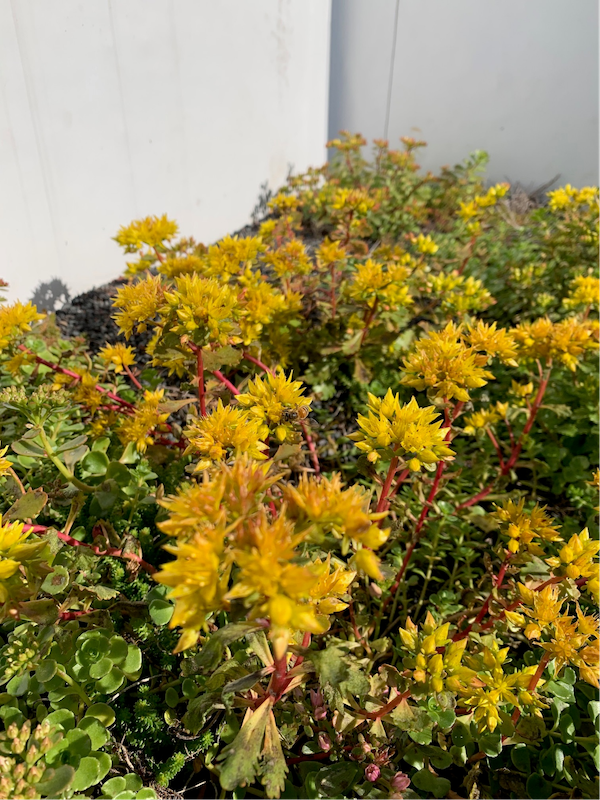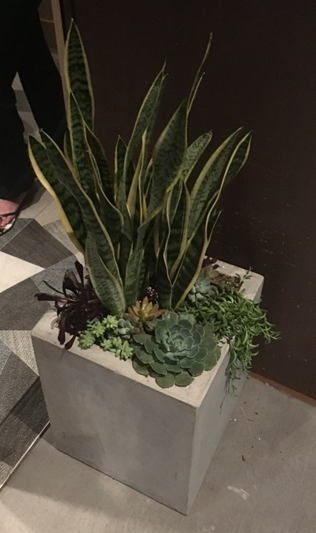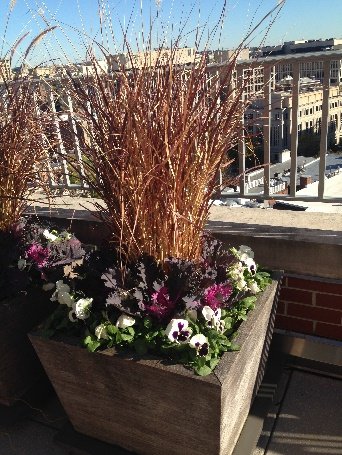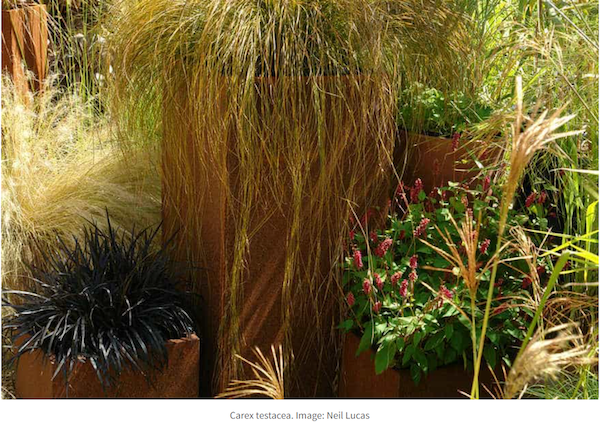Introduction
Container gardening means growing plants in containers instead of directly in the ground. These containers come in various materials, sizes, and shapes. Since they’re movable, you can grow nearly any plant in them. People often use them in small outdoor spaces, doorsteps, balconies, roof decks, or compact gardens. They’re perfect for vertical-growing plants like vines and can add vibrant color to shaded areas. In cities, they allow you to grow vegetables on balconies, attract wildlife to your window, and experience the benefits of biophilia in your everyday life.
“Biophilia is the idea that humans possess and innate tendency to seek connections with nature and other forms of life.”
-Erich Fromm, German-born American psychoanalyst.
Advantages
Container gardening brings plants to places where traditional gardens aren’t possible. It’s ideal for enhancing hardscapes, brightening tight spaces, and creating visual focal points. Growing food in containers helps protect crops from pests like rabbits, deer, and voles. In urban areas, containers contribute to wildlife corridors, supporting pollinators and other animals by providing food, water, shelter, and space.

Strategic Planning for Container Gardens
Site Analysis
Start by thoroughly evaluating your available space. Look at factors like light exposure, wind patterns, and temperature changes throughout the day. Visit the area at different times to identify microclimates that may influence your plant choices. If you’re designing for a commercial location, observe how people move through the space and identify opportunities to enhance the environment. Always include water access in your plan; whether through irrigation systems or manual watering. Don’t overlook this critical component during the planning phase.

Plant Selection
This is the fun creative part! Are you dreaming of a formal display with topiaries and trailing annuals? Maybe you want a vibrant butterfly garden, a mix of vegetables and cut flowers, or simply an overflowing bouquet of seasonal color. Once you define your desired look, pick plants with similar needs in terms of soil, water, and nutrients. This simplifies maintenance and helps prevent pests and diseases.
Choosing Complimentary Plants
Once you figure out what aesthetic you are interested in achieving, gathering a plant selection that requires the same water, type of soil and nutrient levels is key for long-term success. For instance, if you want to use a plant that loves well drained soils, low water, and full sun, make sure all the plants chosen can grow in those same conditions. This makes maintenance easier and more streamlined, and you’ll contend with fewer pests and other problems.
When planting trees in containers think about understory plantings that do well under trees on the ground level. Tree roots will always win out, so picking plants where the root systems are complementary is vital. Typically, traditionally tough plants that are somewhat drought resistant and have more fibrous roots work well.
A key factor to think about in the mid-Atlantic region is plant hardiness. Since roots are less hardy than the tops of plants, pay attention to exposure and plant selection hardiness. You can often see plants that are marginally hardy in our area being sold at local nurseries. They look fantastic and are highly desirable so think about a location that is protected from winter winds or areas prone to cold. You may also want to think about moving the planter to a location that offers more protection when winter arrives.
Container Selection
Containers are available in a wide range of materials and there are pros and cons for each, here are the most popular options:

Metal: provides a modern look and comes in many shapes and sizes. They are frost-proof and durable but more expensive than plastic or clay. Some can suffer from corrosion over long periods of time if not treated well. Metal will be more naturally thermally conductive, so they’ll be hot in the summer sun and cold in the winter.

Concrete: is sturdy and withstands harsh weather conditions, can be dual purposed in physical security construction and is the heaviest product on the market. Don’t expect to move it once placed. It’s low maintenance but can be prone to cracking or chipping over time. There are options utilizing lightweight concretes and glass reinforced concrete that offer the concrete look without the weight.
Container Preparation and Soil Management
Drainage Solutions
Drainage and moisture management should be considered and executed from the beginning for your planter to be successful. Whether indoor or outdoor, roots cannot sit in water and require drainage to avoid root rot. Your first option is to drill drainage holes in the bottom of the planter. Others come with a knockout tab for the drainage hole.
If you use a soilless product such as an intensive green roof media that already drains well with low organic material in it, you can use drainboard material with filter fabric built in to ensure that drainage remains free of debris and doesn’t clog. Whatever you use to keep your drain hole clear, think about the surface the planter is on, make sure it is slightly elevated so that water can flow freely out for proper drainage.
Indoor setting and can’t drain through the planter, consider how to collect the water. One option is to put a saucer at the bottom of the planter (either inside or outside) and put the grow pot inside the planter. Pot liners can be used to either repot the plant directly into it or by placing the grow pot inside a pot liner with drainage material at the bottom. A combination of these methods may vary based on the planter, indoor location needs and grow pot style.
Soil Composition
Soil is the most important factor to consider when setting up your planters with your chosen plants. There are dozens of different soils on the market so make sure you choose one that matches the requirement of your plant selection. Utilize the appropriate topsoil and mix it with soil conditioner to reduce density. Using a heavy topsoil and over-watering will create the potential for root rot to occur.
Conversely, using too light a soil mix such as that found in many potting soils will not provide the nutrient level needed to sustain plants year-after-year. Potting soils are best used when you plan to have annual displays in your planters. After a couple of years, you’ll find that potting soil is depleted from nutrients. You’ll need to refresh it by removing it entirely to ensure the health of the next rotation.
Lastly, an underutilized media on the market for large landscape planters is soilless media pioneered by the green roof industry. This product can be categorized into extensive (less than 6” depth) or intensive (more than 8” depth) versions. Intensive media has more organic content and is perfect for planters with trees, shrubs, perennials and grasses. It drains well and holds its structure so that the media doesn’t ‘shrink’ over time, which is caused by organic material breakdown. It’s a proven media and have been in use for a long time. Extensive media is for lower profile media applications and plantings limited to sedums and other plants who require less water and nutrients. For planters, consider using the intensive media exclusively.

Planting, Care, and Maintenance Techniques for Container Gardening
Planting Timeline
Permanent plants should be planted in early spring after the frost date or in early autumn, so they are established before first frost. Summer annuals can be planted in May with particular care taken with topicals. Frost dates are tricky, and you should consider yearly weather patterns in your research. Listen to local meteorologists and adjust your plan based on their advice. Winter displays and spring bulbs are planted in autumn, and summer bulbs are planted in the spring.

Fertility Management
Plants in containers exhaust nutrients faster due to frequent watering. Build a nutrient management plan into your maintenance schedule. Feed annuals twice a month with a water-soluble fertilizer. For permanent plantings, apply a slow-release fertilizer two to three times a year. Choose a well-balanced type like 14-14-14 or 10-6-4 (N-P-K).
Nitrogen boosts leafy growth and rich green color.
Phosphorus supports root development, flowers, fruits, and seeds.
Potassium promotes overall plant health and balance between root and top growth.
If you prefer organic options, trusted brands like Espoma’s Plant-tone or Flower-tone offer great results.

Pruning and Training
Prune container plants as you would their in-ground counterparts. Remove dead or diseased wood, shape shrubs to encourage dense growth, and cut back perennials when needed. Deadhead annuals by snipping off spent flowers to encourage new blooms and keep plants looking fresh.
Repotting
Over time, roots can become bound in their containers, especially with trees and large shrubs. If your plants decline despite consistent watering and care, the roots might be too dense. Test by probing the soil, if it’s rock-hard, roots are likely restricting water and nutrient absorption. Most container plants thrive for 5–8 years before needing repotting. To extend longevity, divide perennials or grasses and prune roots occasionally. Don’t wait too long, or removing the plant may damage the container or root structure.
Diagnosing and Addressing Issues in Your Container Garden
Retaining Too Much Water
This often happens in winter months if the planters aren’t draining properly. Check to make sure the planter is raised off the ground and that drainage holes are not clogged. Remove any tray so that the standing water doesn’t freeze. If you are getting root rot during the other times of the year, reduce your watering immediately. If you don’t catch it in time and find your soil smells sour, soil replacement will be necessary. Make sure the new soil is more porous and not loaded with organic matter.
Lack of Water
This is typically a problem in the summer and if maintenance doesn’t allow for more frequent waterings changing to more drought tolerant plants or moving the planter to a shadier location may be necessary.
Planting with an Overly Large Container
Scale the planting and root ball sizes to the container size to avoid overplant. If the root ball is significantly smaller than the planter you can experience root rot from the roots sitting in damp organic material. If the root mass is too small underplant with other material that will help absorb water.
Pest and Disease Management
Pest problems can occur when you have stressed out plants, so carefully monitor water and nutrient levels. Common diseases you will see are powdery mildew, root rot, bacterial spot, verticillium wilt, and black spot. Common pests are Aphids, Spider Mites, Thrips, Scale, Mealybugs, Japanese Beetles, slugs and caterpillars. Best practices are to properly identify and manage pests and diseases, when necessary, through integrated pest management (IPM) strategies and preventive measures.
Integrated Pest Management (IPM) is an effective and environmentally sensitive approach to pest management that relies on a combination of common-sense practices. IPM programs use current, comprehensive information on the life cycles of pests and their interaction with the environment. This information, in combination with available pest control methods, is used to manage pest damage by the most economical means, and with the least possible hazard to people, property, and the environment. EPA.gov
Nutrient Deficiency Analysis
Like ground level plantings, nutrient deficiencies consist of:
- Nitrogen – yellowing of leaves
- Phosphorus – purple or bronze coloration on the underside of the leaves due to accumulation of the pigment, Anthocyanin.
- Potassium – leaf edge chlorosis on new matured leaves followed by interveinal scorching and necrosis from leaf edge to midrib.
- Magnesium – older leaves are chlorotic between the veins
- Calcium – new foliage, buds and roots have stunted growth. Younger leaves curl downwards with browning of leaf tips and edge.
- Iron – light green to yellow interveinal chlorosis.
- Manganese – new leaves emerging with diffused interveinal chlorosis.
- Zinc – Chlorsis, bronzing or mottling of young leaves. Interveinal chlorosis followed by reduced shoot growth with short internodes.
- Boron – Plants are stunted and deformed with ‘witches’ broom’
If visual symptoms are observed, conducting a soil test is the best way to determine the cause of these symptoms. Recommended corrective actions and tailored nutrient applications are generated from the soil test results.
Conclusion
Professional Insights
Container gardening should be fun, colorful and a great ‘vessel’ to enjoy growing plants. The key aspects for a successful planting are location, container material and sizing, soil, plants and maintenance. When planned correctly with proper care, they will last a long time before needing to be rotated. If switching out plants seasonally is what you desire, then container gardening is a great and easy way to bring color to a front entrance, rooftop patio or your suburban backyard oasis.

Future Trends
Container gardening in the past involved big bold displays which can still be relevant today, however the movement towards thoughtfully planned pollinator gardens, use of natives, succulent gardens, kitchen gardens, and vertical gardening is where the modern focus is going. Think about having a hummingbird feeder along with bee balm, salvia and a trellis of trumpet vines in a planter. If you have an urban beehive near you and love fresh honey, plant a container with perennials and annuals together such as goldenrod, coneflowers and bee balm with cosmos, allium and verbena. In the dead of winter keep the coneflower seed heads up for the birds to have a tasty treat and underplant with clover so the bees have an early spring food source.
If the informality doesn’t suit your location keep planting bold-shaped evergreens and add elements of grasses that flow in the breeze. Muhly grass, Mexican Feather grass and Japanese Forest grasses can all hold their own as a monoculture in a planter. The different shapes and color of these grasses used in mass really creates a bold statement.
References:
https://www.usda.gov/peoples-garden/gardening-advice/container-gardening
https://www.nal.usda.gov/plant-production-gardening/raised-beds-containers
https://schoolgardening.rhs.org.uk/Resources/Info-Sheet/Container-gardening
https://www.rhs.org.uk/container-gardening/growing-plants-in-containers
https://www.britannica.com/science/biophilia-hypothesis
https://www.provenwinners.com/learn/feed-me-seymour
https://www.espoma.com/product-lines/
https://www.epa.gov/safepestcontrol/integrated-pest-management-ipm-principles
https://www.richardjacksonsgarden.co.uk/five-great-grasses-containers/
